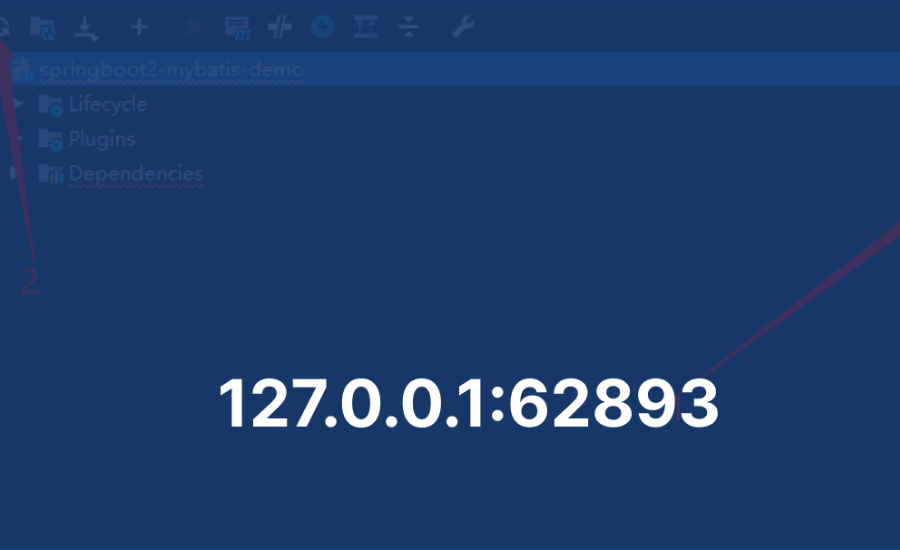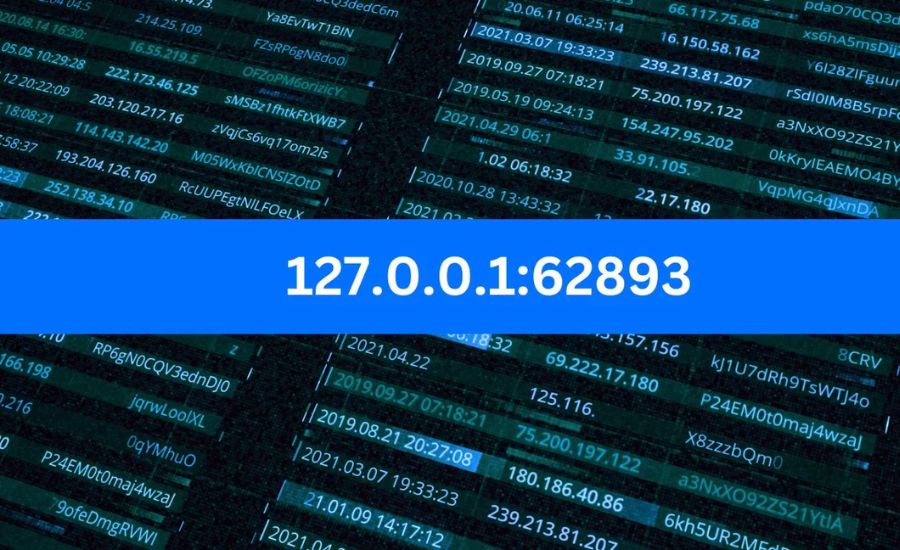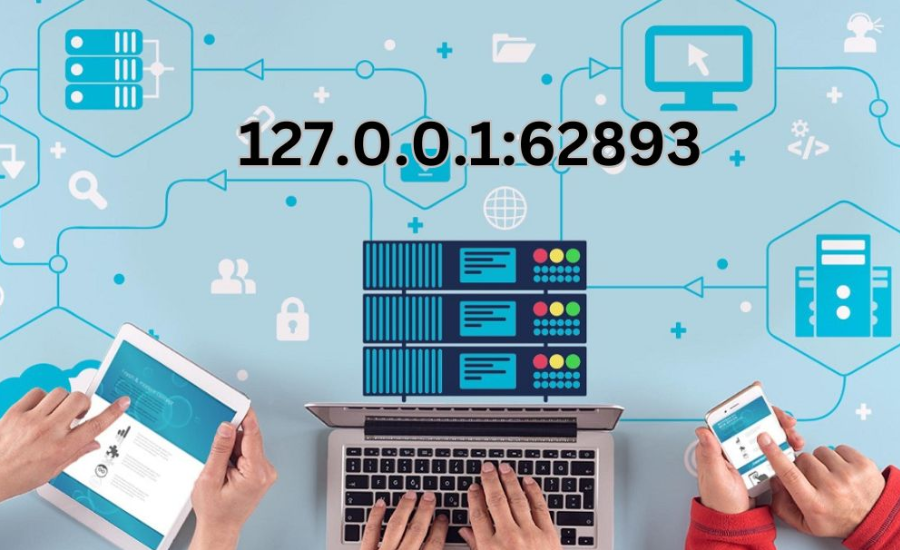Encountering the puzzling sequence 127.0.0.1:62893 during your computer navigation? While it might seem confusing at first glance, understanding its elements can be quite enlightening. The notification “Disconnected from the target VM, address: 127.0.0.1:62893” frequently appears during the development process.
Understanding the Significance of 127.0.0.1:62893

When examining the code 127.0.0.1:62893, it’s important to dissect its two main components to fully grasp its meaning:
127.0.0.1: The Localhost IP Address
The 127.0.0.1 segment refers to an IP address commonly known as “localhost” or “loopback address.” This special address is used to route network traffic back to the same machine from which it originated. Essentially, when you use this IP address, any communication is directed internally within your computer, bypassing external network interfaces. This mechanism is crucial for testing and debugging purposes, allowing developers to run applications locally without needing external network access.
62893: The Port Number
Following the IP address, 62893 represents a port number. Port numbers are used to identify specific applications or services on a machine, facilitating the correct routing of data to and from these applications. In this case, port 62893 is one of the many possible port numbers and, while it may not be as commonly used as some others, it is occasionally linked with services like Memcached—a widely used caching system designed to enhance the performance of web applications by storing frequently accessed data in memory.
Understanding this setup is essential for troubleshooting and optimizing local network interactions and application development.
Troubleshooting Errors with 127.0.0.1:62893

Encountering the error message related to 127.0.0.1:62893 can be challenging, but a systematic approach to troubleshooting can help resolve the issue. Follow these steps to identify and resolve the issue:
Diagnosing the Problem
- Verify Service Operation: First, ensure that the software or service you are trying to access is actively running on your computer. Check whether the application starts correctly, whether it’s a local web server, development tool, or any other service. Sometimes, the service may not be operational, leading to connectivity issues.
- Confirm Port Usage: Check if the application is configured to use port 62893. Ensure that port 62893 is indeed the designated port for the service in question.
- Inspect Firewall Settings: Your computer’s firewall could be blocking traffic on port 62893. To ensure that traffic on this port is not impeded, review and adjust your firewall settings accordingly. Firewalls are designed to protect your system, but they may sometimes block legitimate traffic if not configured properly.
Resolving the Issue
- Start the Service: If you find that the service is not running, initiate it using the appropriate script or command. For web servers or development tools, this usually involves running a specific startup command or script to get the service up and running.
- Adjust Port Numbers: If port 62893 is causing conflicts or is already in use by another service, consider changing the port number for your application. Select an alternative port number that is not in use and update the settings accordingly.
- Configure Firewall: To allow communication through port 62893, you may need to create a firewall exception. Here’s how you can do this based on your operating system:
- Windows: Navigate to Control Panel > Windows Defender Firewall > Advanced Settings > Inbound Rules. Create a new rule to permit traffic through port 62893.
- Mac/Linux: Use Terminal commands to adjust firewall settings. Ensure you add rules that allow traffic through the specified port.
- Check Application-Specific Settings: Some applications may require additional configuration to function correctly. Refer to the application’s official documentation to verify that all necessary settings are correctly applied and that the application is configured to use the correct port.
- Utilize Network Diagnostic Tools: Use network diagnostic tools to gain insights into port usage. For example:
- Unix/Linux: Use lsof to check if any processes are using port 62893.
- Windows: Use netstat to identify any applications listening on port 62893.
By following these steps, you can effectively troubleshoot and resolve issues related to 127.0.0.1:62893, ensuring smooth operation of your services and applications.
Understanding IP Addresses: A Comprehensive Overview

IP addresses are integral to the digital world, serving as the online equivalents of physical home addresses. They enable the routing of data by specifying its destination and outlining the path it should travel. Today, there are two main types of IP addresses: IPv4 and IPv6.
IPv4 and IPv6: The Basics
- IPv4 Addresses: IPv4, or Internet Protocol version 4, is the older and more widely known version of IP addresses. An example of an IPv4 address is 127.0.0.1. As the number of internet-connected devices continues to grow, the limited supply of IPv4 addresses is becoming more constrained.
- IPv6 Addresses: IPv6, or Internet Protocol version 6, was developed to address the limitations of IPv4. It provides a vastly larger address space, ensuring that the internet can continue to expand. An example of an IPv6 address is 2001:0db8:85a3:0000:0000:8a2e:0370:7334. The adoption of IPv6 is essential for accommodating the burgeoning number of internet-connected devices.
Private vs. Public IP Addresses
- Private IP Addresses: Private IP addresses, such as 127.0.0.1, are used within local networks and are not accessible from the broader internet. These addresses are employed for internal communication between devices on the same network or within a single device, facilitating efficient and secure data exchange in a contained environment.
- Public IP Addresses: In contrast, public IP addresses are used for communication across the global internet. They enable devices to interact with other devices worldwide, making them crucial for accessing web services, sending emails, and engaging in other internet-based activities.
Understanding the role and functionality of IP addresses is fundamental to navigating and managing network communications effectively. By grasping the differences between IPv4 and IPv6, as well as private and public IP addresses, you can better appreciate how data is routed and managed in the digital landscape.
Understanding Port Numbers: A Detailed Explanation

Port numbers play a crucial role in directing network traffic to the appropriate applications on your device, much like how TV channels help you find specific programs. These numerical identifiers ensure that data packets reach their intended destination within a system, facilitating smooth communication between various applications and services.
The Role of Port Numbers
Port numbers function as communication endpoints in the network layer, helping to manage data flow between devices and applications. Here’s a closer look at how port numbers operate:
- Functionality: Just as TV channels direct you to different television shows, port numbers direct network traffic to specific applications or services on your device. For example, web traffic typically uses port 80 for HTTP and port 443 for HTTPS.
- Types of Ports: Port numbers are categorized into three ranges:
- Well-Known Ports: Ranging from 0 to 1023, these ports are reserved for widely-used protocols and services, such as port 80 for web traffic (HTTP) and port 25 for email (SMTP).
- Registered Ports: Spanning from 1024 to 49151, these ports are assigned to specific applications and services by software vendors. These ports are less standardized but still widely used for various applications.
- Dynamic or Private Ports: Ranging from 49152 to 65535, these ports are used for temporary or private connections. They are often allocated dynamically by applications when initiating a connection.
Why Port Numbers Matter
Port numbers are essential for network communication as they help in distinguishing between different services running on the same device
Understanding port numbers enhances your ability to manage network traffic, troubleshoot connectivity issues, and configure network settings effectively. They are a fundamental part of network communication, enabling diverse applications to function seamlessly and interact with each other.
The Risks of Publicly Exposing Port 62893

Exposing port 62893 to the public internet generally poses significant security risks. Here’s why maintaining this port’s confidentiality is crucial:
Security Vulnerabilities
Port 62893, if associated with services such as Memcached, can present several security risks. Hackers may use these weaknesses to gain unauthorized access to your system or manipulate its functions.
Increased Attack Surface
Public exposure of port 62893 makes it a target for various types of cyber attacks. Attackers could launch distributed denial-of-service (DDoS) attacks, overwhelming your system with excessive traffic. This could lead to system crashes, significant downtime, and potential data loss, severely impacting operational efficiency.
Risk of Unauthorized Access
When port 62893 is accessible from outside your network, it opens the door for unauthorized users to attempt connections. Without proper security measures, malicious actors could potentially gain access to sensitive information or control the service running on this port. This unauthorized access can lead to data breaches or other security incidents.
Best Practices for Security
To minimize these risks, it is advisable to restrict port 62893 to internal use only. This means limiting access to trusted networks and preventing external entities from connecting to it. Implementing robust firewall rules and access controls can further safeguard your systems from potential threats.
Benefits of Utilizing 127.0.0.1:62893

The IP address and port combination 127.0.0.1:62893 offers several key advantages, particularly in development and security contexts:
- Development and Testing: This local address is crucial for developers who need to test applications without exposing them to external networks. By using 127.0.0.1:62893, developers can create a controlled environment where they can test and debug their software safely, free from potential external interferences. This setup helps in identifying and addressing bugs effectively before deployment.
- Understanding Networking Concepts: Working with localhost and specific port numbers like 62893 provides valuable insights into fundamental networking principles. It helps developers and IT professionals grasp how client-server interactions work and how protocols such as TCP/IP operate within a local context.
- Enhanced Security: Using 127.0.0.1:62893 for monitoring purposes allows for the tracking of port activities and any unusual access attempts. This can significantly bolster security by enabling early detection of potential threats or unauthorized attempts to interact with the system, thus fortifying overall system security.
- Efficient Debugging: Localhost addresses are instrumental in diagnosing network-related issues. By isolating the development environment, developers can focus on resolving connectivity problems and performance issues more efficiently, leading to smoother operation and higher-quality applications.
- Isolated Development Environment: Localhost provides a separate space for development and testing, preventing conflicts with other applications and services running on the system. This segregation ensures that the application runs in an optimal and reliable environment, free from the impact of external factors or interference from other software.
By leveraging the unique features of 127.0.0.1:62893, developers can enhance their workflows, secure their systems, and improve their understanding of networking and application performance.
Common Applications of Localhost
Localhost, represented by the IP address 127.0.0.1, is a versatile tool with several important uses in computing and software development:
- Local Development and Testing: Developers frequently use localhost as a private environment for creating and testing applications. This local setup allows them to experiment with code and features without affecting live systems or needing external network access. By working on localhost, developers can fine-tune their applications, fix bugs, and validate functionalities in a secure, isolated setting before the software is made publicly available.
- Software Demonstrations: Localhost is often employed for conducting software demos and trials. It enables users to showcase the functionality and features of applications without relying on internet connectivity.
- Educational Purposes: Localhost provides a valuable platform for learning and understanding network concepts and server management. Students and educators use it to simulate server environments, practice networking skills, and gain hands-on experience with server configurations and web technologies.
- Security Testing: Utilizing localhost is essential for performing security assessments and vulnerability testing. By replicating a production environment locally, security professionals can analyze potential threats and vulnerabilities in a safe, controlled manner, ensuring that any issues are identified and addressed before deployment.
- Configuration and Debugging: Localhost is instrumental in configuring and debugging various software applications. It allows developers to troubleshoot and resolve issues in a controlled environment, ensuring that applications perform optimally before they are integrated into a broader network or released to end-users.
- Prototype Development: When developing prototypes or proof-of-concept applications, localhost offers a quick and efficient platform for initial development and iteration. It provides the flexibility to rapidly test ideas and features without the need for a live server environment.
Tools for Managing Localhost and Port Configurations
Effectively managing localhost and port settings is crucial for maintaining network and application stability. Several tools can aid in this process, each offering unique functionalities to streamline diagnostics and monitoring:
- Wireshark: Wireshark is a powerful network protocol analyzer widely used for troubleshooting network problems and dissecting network traffic. It captures and inspects data packets transmitted over the network, providing detailed insights into network behavior and helping identify anomalies, bottlenecks, or security issues.
- PortQry: PortQry is a versatile command-line utility designed to query the status of network ports. By checking whether specific ports are open or closed, PortQry helps diagnose connectivity problems and verify port configurations. It is particularly useful for troubleshooting issues related to network services and ensuring proper port allocation.
- Nmap: Nmap, short for Network Mapper, is an essential tool for network discovery and security assessment. It performs comprehensive scans of networks to identify active devices, open ports, and services running on those ports.
- Netcat: Often referred to as “nc,” Netcat is a versatile networking utility used for reading from and writing to network connections using TCP or UDP protocols. It is useful for debugging and testing network services and can function as a port scanner or a simple network data transfer tool.
- TCPView: TCPView provides a detailed view of all active TCP and UDP connections on a system. This graphical tool shows the status of each connection, including local and remote IP addresses, port numbers, and connection states, making it easier to monitor network activity and troubleshoot connectivity issues.
- Fiddler: Fiddler is a web debugging proxy that logs HTTP and HTTPS traffic between your computer and the internet. It helps in debugging and analyzing web traffic, allowing users to inspect request and response headers, view cookies, and test web applications.
- Little Snitch: Designed for macOS, Little Snitch monitors outgoing network connections and provides notifications about network activity. It enables users to control which applications can connect to the internet and helps identify and block unauthorized data transmissions.
Understanding the Functionality of 127.0.0.1:62893

The address 127.0.0.1:62893 plays a key role in local network communication by serving specific functions:
- Initiating Communication: When an application on your computer needs to communicate with another process, it uses this address to establish a connection. The process starts by sending a request to the address 127.0.0.1, also known as “localhost,” which refers to the local machine itself.
- Localhost as the Destination: The address 127.0.0.1 represents the loopback interface of your computer. This internal routing is crucial for tasks that require local communication without leaving the computer.
- Role of the Port Number: The port number, 62893 in this case, acts as a specific identifier for the communication request. It tells the operating system which particular service or application should handle the incoming data.
- Practical Example: Consider a development environment where you are using a tool to debug a web application. The tool might use the address 127.0.0.1:62893 to connect to a local server instance running on your machine. This setup allows you to test and debug the application in a controlled environment without involving external servers or networks.
Risks of Publicly Exposing Port 62893
Opening port 62893 to public access generally poses several security risks:
- Susceptibility to Denial-of-Service (DoS) Attacks: Publicly exposing port 62893 increases the risk of DoS attacks. Attackers can overwhelm your system with excessive traffic directed at this port, leading to crashes, unresponsiveness, or service outages. Such attacks can severely disrupt normal operations and affect system stability.
- Increased Risk of Unauthorized Access: When port 62893 is accessible from the internet, it opens a potential entry point for unauthorized users to connect to your Memcached server. This exposure significantly raises the risk of unauthorized access, which can lead to data breaches, security violations, or unauthorized manipulation of your system.
- Exploitation of Security Vulnerabilities: If there are existing security vulnerabilities in the Memcached service or any application running on port 62893, these weaknesses can be exploited by malicious actors. Attackers may leverage these vulnerabilities to gain unauthorized access, execute malicious commands, or compromise the integrity of your system.
Implementing robust firewall rules and access controls can help protect your system from potential threats and maintain overall security.
Facts About 127.0.0.1:62893
- Address Breakdown:
- 127.0.0.1: Known as the “localhost” or “loopback address,” this IP address is used to route network traffic back to the same machine for internal communication and testing.
- 62893: This port number is used to direct traffic to a specific application or service running on the local machine.
- Common Use Cases:
- Development and Testing: 127.0.0.1:62893 is often used by developers to test and debug applications in a controlled environment without external network access.
- Local Server Connections: It allows applications to connect to local servers or services running on the same device.
- Security Risks:
- Denial-of-Service (DoS) Attacks: Exposing port 62893 to the public can make systems vulnerable to attacks that flood the port with excessive traffic, potentially causing crashes and unresponsiveness.
- Unauthorized Access: Publicly accessible ports increase the risk of unauthorized connections and data breaches.
- Port Number Categories:
- Well-Known Ports: 0-1023, used for standard services (e.g., HTTP on port 80).
- Registered Ports: 1024-49151, assigned for specific applications.
- Dynamic or Private Ports: 49152-65535, used for temporary connections.
FAQs About 127.0.0.1:62893
Q: What does the IP address 127.0.0.1 signify?
A: The IP address 127.0.0.1 is known as “localhost” or “loopback address.” It routes network traffic internally within the same computer, making it essential for local testing and debugging.
Q: How does port number 62893 fit into the communication process?
A: Port number 62893 identifies the specific service or application on the local machine that should handle incoming data. It ensures that traffic is directed to the correct process or service.
Q: What are the risks of exposing port 62893 to the public?
A: Exposing port 62893 to the public can lead to security risks such as susceptibility to Denial-of-Service (DoS) attacks, unauthorized access, and exploitation of vulnerabilities in services running on this port.
Q: How can I troubleshoot issues with 127.0.0.1:62893?
A: To troubleshoot, verify that the service is running, confirm that the correct port is being used, inspect firewall settings, and check for application-specific issues. Adjusting port numbers or firewall configurations may also help resolve connectivity issues.
Q: What tools can help manage localhost and port configurations?
A: Tools like Wireshark, PortQry, Nmap, Netcat, TCPView, Fiddler, and Little Snitch are useful for managing and troubleshooting localhost and port settings, providing insights into network traffic and connectivity.
Conclusion
Understanding the address 127.0.0.1:62893 is crucial for managing local network communications, particularly in development and testing environments. This address facilitates internal routing of network traffic within the same machine, with the port number directing data to specific services or applications. However, exposing port 62893 to the public internet can pose significant security risks, including susceptibility to DoS attacks, unauthorized access, and exploitation of vulnerabilities. By leveraging these practices, developers and IT professionals can ensure the secure and efficient operation of their local systems and applications.
Read More: News Link Times
